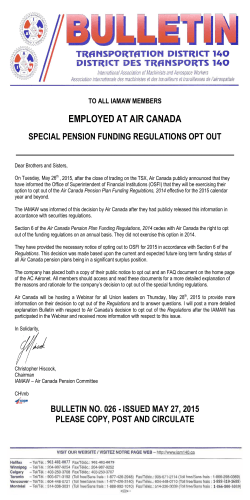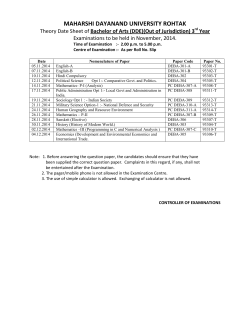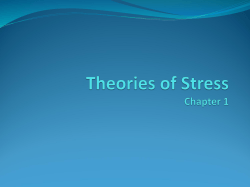
The Importance of Hope and Coping in Addiction Recovery
Spencer D. Bradshaw, PhD “A Core Experience of ‘Spirituality’” The Center for Family Systems Research & Intervention The Center for Collegiate Recovery Communities Dr. Sterling T. Shumway Dr. Jared P. Dempsey Dr. Kitty S. Harris Hannah Wilhite Mazie Zielinski Von Poll Alison Wagner Tramel Pennie Ryan Burden Samantha Curtis Caleb Herrera Kaitlin George Dr. Thomas G. Kimball Hazelden Press Dr. Shumway’s Advice Dr. Kimball’s Advice • Using • Anger • Lying • Manipulation • Guilt • Blaming • Hiding • Escaping • Denial • Rationalizing • • • • • • • • • • Meditation Deep Breathing Music Journaling Meetings Education Prayer Asking for help Exercise 12‐steps Age when first Drunk Years of Drinking Years Sober Gender Mean Min Max SD 14.94 11 18 1.61 8.28 1.16 23.33 6.3 3.1 .12 9.57 2.7 Female Male 4 (25%) 12 (75%) Hope Items: • • • • • The future appears bright to me I have a reason for living Things are looking up I see a purpose for my life I will never get better Opt Opt 1 2 Opt Opt Opt 3 4 5 Hope ‐.052 ‐.272 .058 ‐.164 ‐.122 ‐.197 ‐.457 ‐.310 ‐.402 ‐.229 ‐.310 ‐.245 .177 ‐.220 ‐.324 ‐.342 Coping ‐.332 ‐.481 ‐.367 ‐.341 ‐.423 ‐.505* ‐.592** ‐.676*** ‐.674*** ‐.498* ‐.548* ‐.500* .060 ‐.493 ‐.328 ‐.428 Notes: *<.05 **<.025 ***<.01 Opt 6 Opt 7 Opt 8 Opt 9 Opt 10 Opt 11 Opt 12 Opt Opt Opt 13 14 15 Opt 16 HbT Blood Flow (Volume) Coping HbT Blood Flow (Volume) Coping Coping HbT Blood Flow (Volume) Difference in brain activation on optodes 7, 8, and 9 between the “Hi‐Copers” and “Low‐Copers”. Activation shown is unique activation for “Hi‐Copers” after subtracting activation for the “Low‐Copers”. Bradshaw, S. D., Shumway, S. T., Wang, E. W., & Harris, K. S. (2014). Addiction and the Mediation of Hope on Craving, Readiness, and Coping. Journal of Groups in Addiction & Recovery, 9(4), 294-312. Carvajal, S. C., Clair, S. D., Nash, S. G., & Evans, R. I. (1998). Relating optimism, hope, and self-esteem to social influences in deterring substance use in adolescents. Journal Of Social And Clinical Psychology, 17(4), 443465. doi:10.1521/jscp.1998.17.4.443 Chung, T., Langenbucher, J., Labouvie, E., Pandina, R. J., & Moos, R. H. (2001). Changes in alcoholic patients' coping responses predict 12-month treatment outcomes. Journal Of Consulting And Clinical Psychology, 69(1), 92-100. du Boisgueheneuc, F., Levy, R., Volle, E., Seassau, M., Duffau, H., Kinkingnehun, S., ... & Dubois, B. (2006). Functions of the left superior frontal gyrus in humans: a lesion study. Brain, 129(12), 3315-3328. Greene, J. D., Nystrom, L. E., Engell, A. D., Darley, J. M., & Cohen, J. D. (2004). The neural bases of cognitive conflict and control in moral judgment. Neuron, 44(2), 389-400. Gusnard, D. A., Akbudak, E., Shulman, G. L., & Raichle, M. E. (2001). Medial prefrontal cortex and self-referential mental activity: relation to a default mode of brain function. Proceedings of the National Academy of Sciences, 98(7), 4259-4264. Irving, L. M., Seidner, A. L., Burling, T. A., Pagliarini, R., & Robbins-Sisco, D. (1998). Hope and recovery from substance dependence in homeless veterans. Journal Of Social And Clinical Psychology, 17(4), 389-406. doi:10.1521/jscp.1998.17.4.389 Jackson, R., Wernicke, R., & Haaga, D. F. (2003). Hope as a predictor of entering substance Abuse treatment. Addictive Behaviors, 28(1), 13. Litt, M. D., Kadden, R. M., Cooney, N. L., & Kabela, E. (2003). Coping skills and treatment outcomes in cognitive-behavioral and interactional group therapy for alcoholism. Journal of Consulting and Clinical Psychology, 71(1), 118. Majer, J. M., Droege, J. R., & Jason, L. A. (2012). Coping strategies in 12-step recovery: More evidence for categorical involvement. Journal of Groups in Addiction & Recovery, 7(1), 3-14. MacLean, P. D. (1990). The triune brain in evolution: Role in paleocerebral functions. Springer Science & Business Media. Moore, B. C., Biegel, D. E., & McMahon, T. J. (2011). Maladaptive coping as a mediator of family stress. Journal of social work practice in the addictions, 11(1), 17-39. Shumway, S. T., Dakin, J. B., Smock Jordan, S. A., Kimball, T. G., Harris, K. S., & Bradshaw, S. D. (2014). The Development of the Hope and Coping in Recovery Measure (HCRM). Journal of Groups in Addiction & Recovery, 9(4), 280-293. Shumway, S. T., & Kimball, T. G. (2012). Six essentials to achieve lasting recovery. Hazelden Publishing. Strack, S., Carver, C. S., & Blaney, P. H. (1987). Predicting Successful Completion of an Aftercare Program Following Treatment for Alcoholism: The Role of Dispositional Optimism. Journal Of Personality & Social Psychology, 53(3), 579-584. Sowards, K., O'Boyle, K., & Weissman, M. (2006). Inspiring hope, envisioning alternatives: the importance of peer role models in a mandated treatment program for women. Journal Of Social Work Practice In The Addictions, 6(4), 55-70 Waytz, A., Zaki, J., & Mitchell, J. P. (2012). Response of dorsomedial prefrontal cortex predicts altruistic behavior. The Journal of Neuroscience, 32(22), 7646-7650.
© Copyright 2025

















